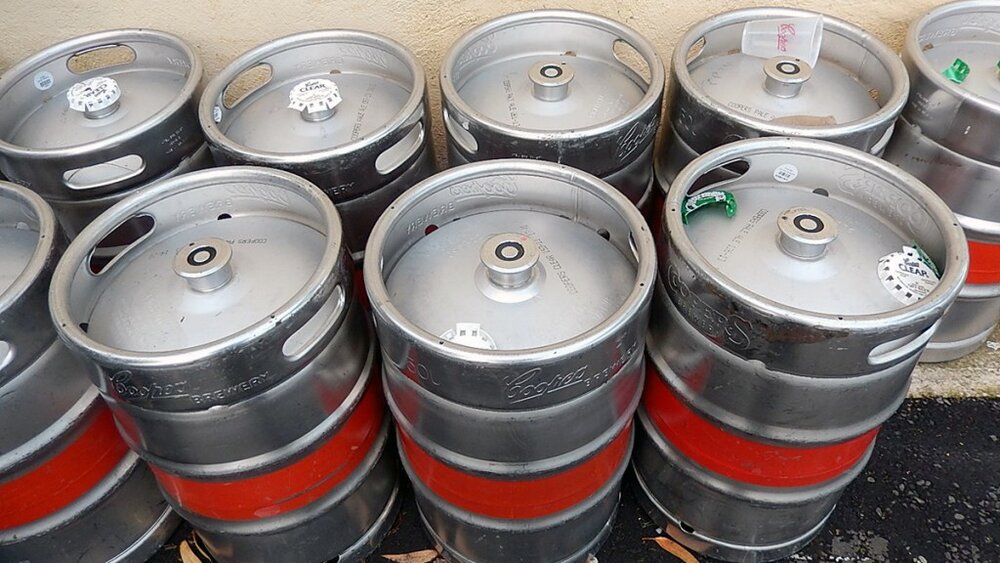The short answer is no. If you’re tasting metal, it’s not in the beer. You’re probably tasting metal because your mouth is in direct contact with the metal of the container. However, most people should not taste anything when drinking from clean stainless steel, so if that’s happening to you, let’s see what we can do to solve the problem.
Before continuing, we need to acknowledge that the containers for beer BeerWhere sells are almost all stainless steel. Plastic and glass have their own issues, but a metallic taste is usually not one of them.
Beer and Stainless Steel
We at BeerWhere don’t worry about carrying beer around in stainless steel growlers and drinking it from stainless steel tumblers because most beer has already spent a lot of time in contact with stainless steel before it ever gets to your fridge and mouth. Brewing equipment, such as mash tuns, brew kettles and fermenters, are usually made of stainless steel (with a few brew systems also sporting nickel-plated copper or iron components). Beer can corrode nickel but not stainless steel.
When you visit your local taproom, you’re going to be drinking beer that has been in a stainless steel keg for days, weeks or even months. While there are a few alternatives out there, the majority of draft beer is packaged in unlined kegs usually made of 304 or 316 stainless steel. If stainless steel directly affected the taste of beer, it would be an international emergency!
I still taste metal. Am I crazy?
These are two separate issues, and we aren’t qualified to help you with the latter. There are many reasons you could be tasting metal. You could be pregnant, be suffering from gum disease or have received a massive dose of radiation. For the purposes of our discussion, we’re going to assume you only taste metal when you’re drinking from a metal container.
If you taste metal when you’re eating with stainless steel flatware — the forks and spoons you eat with every day — taste metallic to you, then your senses are obviously extremely sensitive to the effects of metal, and there’s probably not much you can do but switch materials. If stainless spoons don’t bother you, trying drinking from your problem container using a plastic straw or travel lid. You want to get your lips and nose away from the metal. Is there still a metallic taste?
Most of the time, we can’t taste metal directly because our saliva can't dissolve metal. What perceive as a metallic taste and smell are the reactions between the metal and other chemical compounds present in our mouth and on our skin. The strength of this reaction and sensitivity to it varies widely from person to person.
Stainless steel is covered in a thin, transparent layer of chromium oxide that is inert. It doesn't react with anything. It doesn’t dissolve in water, and it doesn’t conduct electricity. It doesn't react with your saliva to allow you to taste anything. If you’re tasting metal, there’s likely something else present that is reacting with compounds on your body. Time to clean.
Clean it like you mean it, then passivate
Yes, we know you’ve already scrubbed it with hot, soapy water, but do it again anyway. You can use a brush, sponge or cloth, but don’t use anything abrasive or caustic, especially not steel wool or bleach. You don’t want to scratch or damage that chromium oxide layer. Although stainless steel is generally safe for the dishwasher, you might want to stick to hand washing if you are getting a metallic taste. Dishwasher detergent is pretty caustic.
The next thing you’re going to do is passivate the surface of the stainless steel. Passivation uses an acid to remove free iron and other metals that can be present as a residue from the manufacturing process. You can use something like citric acid, but good old-fashioned distilled white vinegar will do the job.
Fill your container with a mixture of 50% tap water and 50% white distilled vinegar. Let it sit for 24 hours. Dump out the contents and rinse out the container thoroughly with warm water. Fill it with a beverage (or just lick it) and give it a test. If the taste is still there, repeat the process. If the taste is gone but comes back later, repeat the process. Remember, you need to passivate all the surfaces that come in contact with your mouth and skin. This means you will also want to soak the rim or opening in vinegar, as well. Place your container upside down in a bowl of vinegar and water making sure there’s enough solution to cover any areas the you might put your mouth on.
Finally, some people recommend the same process but using baking soda instead of vinegar. Baking soda is alkaline, not acidic, so it would not help to passivate the stainless steel. It likely would act as a detergent to clean the steel so it certainly isn’t going to hurt anything if you try it.
BeerWhere can help
The BeerWhere 6PINT 20 oz. Tumbler was designed with some of our friends in mind who don't like drinking from metal. The 6PINT comes with a food-safe silicone cover for the stainless steel rim that keeps your mouth off the metal. The 6PINT is also shaped to hold and insulate a pint glass or a 12 oz. to 24 oz. plastic cup that you can use as a liner. You can use the silicone cover and a liner cup together or separately to get the fit and coverage you want. The 6PINT gives you all the benefits of vacuum insulation without every having your beer in contact with metal.

